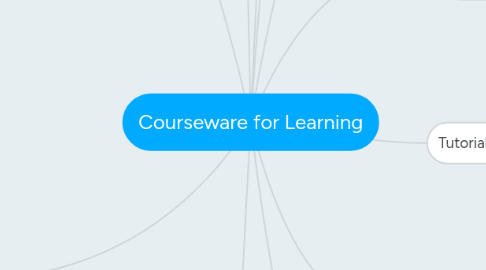
1. Beginnings of Educational Programming
1.1. Based on Behaviorism
1.1.1. Very restricted learning
2. Simulations
2.1. Model a phenomenon or activity that users learn about through interaction with the simulation
2.1.1. Saftey
2.1.1.1. "If a mistake is made during a simulated landing of a jet, no one is killed!"
2.1.2. Modification of time frames
2.1.2.1. Speeding or slowing time: evolution, climate change, the behavior of an atom
2.1.3. Making rare events more common
2.1.3.1. Large asteroid striking the earth
2.1.4. Controlling the complexity of a phenomenon
2.1.4.1. Being able to focus on individual aspects of the behavior of a bacterium in the bloodstream
2.1.5. Enhancement of motivation to learn
2.1.5.1. Students tend to enjoy activities that are close to "real life" experiences
2.1.6. Transfer of learning
2.1.6.1. The closer a simulation is to reality, the more likely there is to be strong transfer of learning
3. Educational Games
3.1. Examples of games
3.1.1. Adventure games
3.1.2. Role Playing games
3.1.3. Logic and puzzle games
3.1.4. Word games
3.2. Factors in games
3.2.1. Goals
3.2.2. Rules
3.2.3. Players
3.2.4. Directions
3.2.5. Constraints
3.2.6. Penalties
3.2.7. Scenarios
3.2.8. Choices
3.3. Potential Advantages of Games
3.3.1. Motivation to learn
3.3.2. Students tend to invest a lot of cognitive effort when playing games
3.3.3. Develop knowledge and skills
3.3.4. Can develop collaborative skills
3.4. Potential Pitfalls of Games
3.4.1. Some games can instigate debilitating levels of competition
3.4.2. Some games rely too much on change instead of knowledge or skills
3.4.3. It can be difficult for game designers to strike a balance between educational goals and the various characteristics of games
4. Tools and Open-Ended Learning Environments
4.1. Emphasize learning by discovery and exploration, problem solving, and by teaching things to the computer or other students
4.1.1. Examples
4.1.1.1. LOGO
4.1.1.2. Scratch
4.1.1.3. Google Sites
4.1.1.4. Inspiration
4.1.1.5. Mind Meister
4.1.1.6. The Adventures of Jasper Woodbury
4.1.2. Potential Advantages of Tools and Open-Ended Learning Environments
4.1.2.1. Deep learning and transfer
4.1.2.2. Collaborative learning
4.1.2.3. Motivation
4.1.2.4. Cross-curricular learning
4.1.3. Potential Pitfalls
4.1.3.1. Not sutiable for all learners
4.1.3.2. Some teachers are unable to adapt to new roles
4.1.3.3. Assessment and evaluation of learning can be difficult
4.1.3.4. Large investment of instructor and student time
5. Affordable microcomputers
5.1. Brought Courseware to the classroom
5.1.1. IBM,PCs, APPLE, IIEs
6. Macintosh Computer (1980s)
6.1. Began to bring multimedia into the classroom
7. 4 Phases of Instruction
7.1. Introduce and present information
7.1.1. i.e. content and/or skills
7.2. Guide the learner in using the content/skills
7.3. Practice the content and/or skills
7.4. Assess learning
7.4.1. test, performances, etc.
8. Methodologies for Facilitating Instruction with Educational Technology
8.1. Tutorials
8.2. Hypermedia
8.3. Drills
8.4. Simulations
8.5. Educational Games
8.6. Tools and Open-ended Learning Environments
9. Tutorials
9.1. Information is presented or skills are molded
9.2. The learner is guided through the initial use of information or skills
10. Hypermedia
10.1. Collection of texts, images, audio files, videos, and various combinations that focus on a topic or a related set of topics
10.1.1. Encyclopedias/reference sources
10.1.2. Student projects in which students create their hypermedia/multimedia products
10.1.2.1. WebQuests, Wikis, Hypercompostions
10.1.3. Case studies
10.1.4. Virtual museums
10.1.5. Virtual field trips
11. Drills
11.1. Created to provide practice
11.1.1. Incorporate multimedia and game-like features to be more appealing
